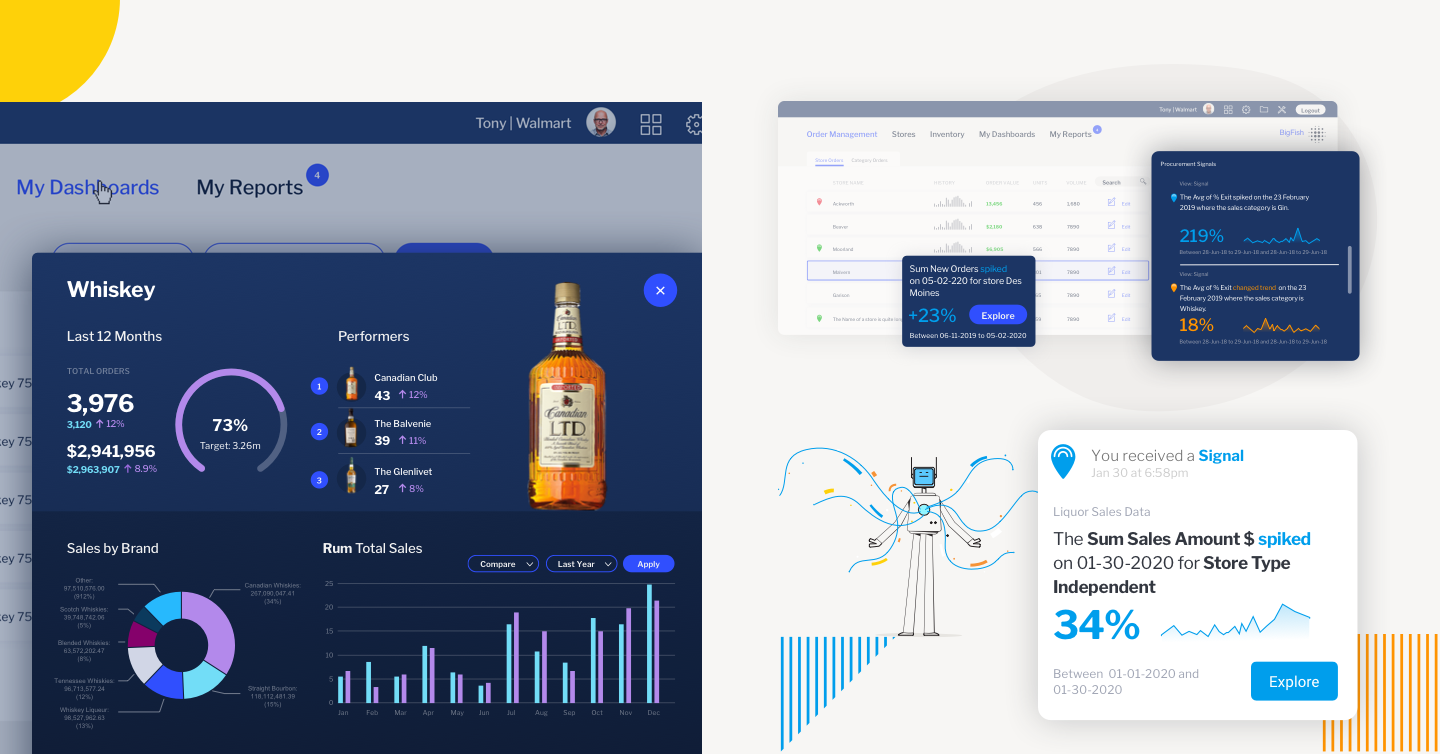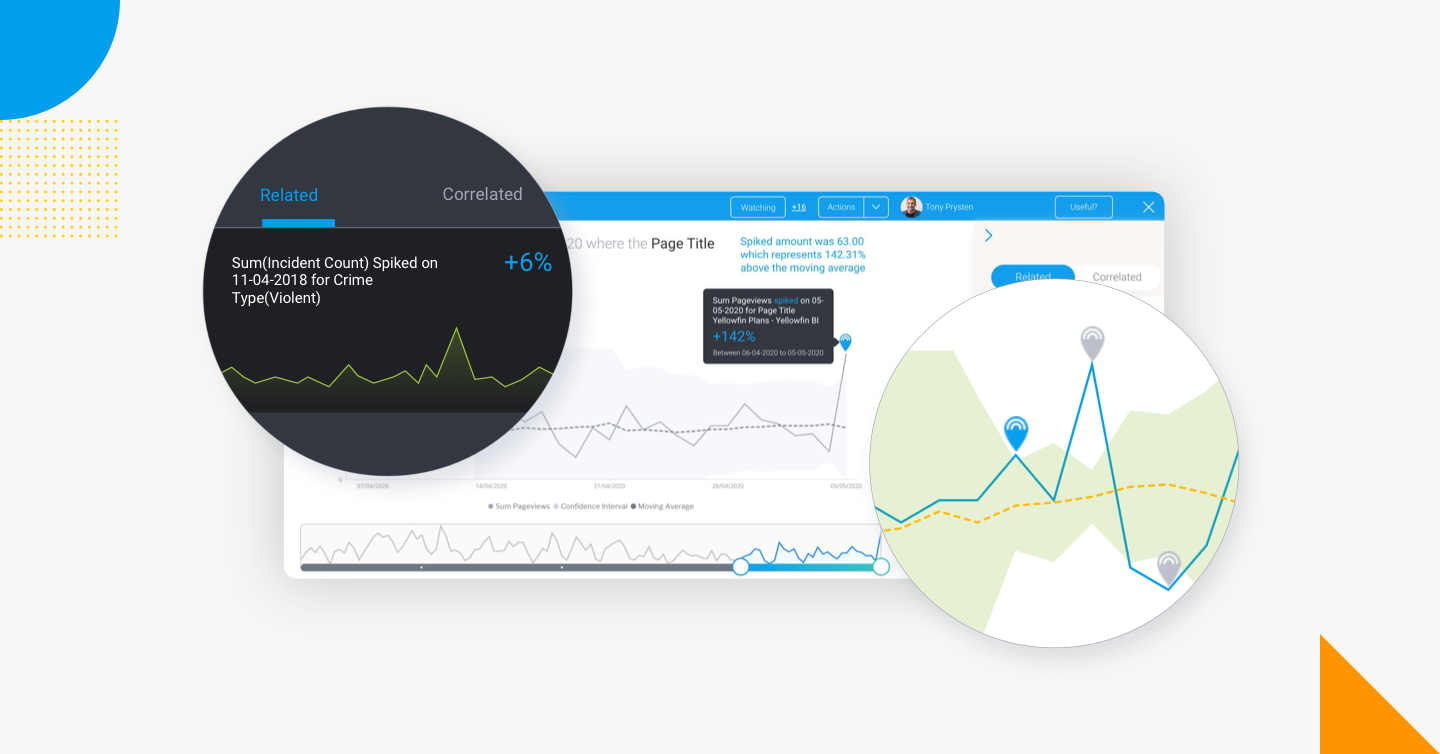
Dashboards vs automated business monitoring: What's the difference?
Dashboards are synonymous with business intelligence and monitoring for good reason. When we need visualized answers to the questions we have from our most important data, it's a great tool for discerning key metrics at-a-glance.
In 2021, however, expecting users to rely solely on dashboards for BI needs isn't enough.
Why?
Data is growing exponentially - in both size and complexity - within every business today. Manually keeping track of performance and searching for insights has become difficult for many users, and it's fostered new expectations - to be able to do more with analytics - such as making it faster and easier for all to keep on top of changes or opportunities.
The main challenge that has arisen is a lack of time, resulting in typical pain-points:
- Dashboard consumers have to manually scan for issues and trends to ensure the business is both proactively tracking and alerted to any critical changes that need action - which is prone to analysis fatigue and subject to strict, timely requirements.
- Dashboards naturally only have space for a limited number of KPIs or metrics to be integrated and presented, which means your users are only looking at smaller, more specific data - not necessarily the right areas that could offer up hidden insights.
- There’s just too much continuously incoming business data to integrate, manage and analyze that users won’t be able to drill down into in a reasonable time-frame.
Thankfully, top embedded BI platforms today have extended their data discovery, monitoring and storytelling capabilities in response to these needs through automation, which helps users not only become more efficient in reading their data, but in finding new, more relevant insights. These features - known as automated business monitoring, or automated analytics - have fundamentally changed the way we do BI today - without replacing the reliable and useful purpose of having an overview of key data (dashboards).
Wondering what the difference is between dashboards and automated analytics? Now is the time to familiarize yourself with just how helpful these analytics tools can be for your app - and your users’ increasing BI needs - so you know how it can fit your use case.
Dashboards for business intelligence
First and foremost, dashboards aren’t going anywhere, nor are they inherently bad.
As more innovative analytics technologies become mainstream, however, the use of dashboards will naturally decline over time - so it’s important to be prepared. But make no mistake - there will always be a use case for operational dashboards in most businesses.
So, what are they best for?
Dashboards are great for monitoring a known set of key metrics over a set period of time. If your users have already identified important KPIs they need to track, having a business overview that’s easy to glance over and proactively watch is very helpful to have.
Modern BI tools like Yellowfin have elevated data discovery and data storytelling possible with just dashboards even further, with richly visualized reporting capabilities that enable regular business users to make their dashboards even more interactive in nature and collaborative in design than they traditionally once were.

But the use cases for analytics - and what our users want from them - is evolving rapidly.
- What if your users want to know about the unknown metrics, instead of just monitoring known ones?
- What if your dataset is just becoming too big or too complex for them to explore?
- What if there’s disruptions, patterns, or trends - insights - they’re missing or can’t see?
For these newer use cases, you can see using just dashboards for BI has its limitations.
The most common issue we hear at Yellowfin is that regular business users might want to go beyond the data that fits neatly on their dashboard, as oftentimes they're forced to aggregate datasets for hard averages, reducing the visibility they have into the underlying areas of performance - and the ability to hunt for relevant patterns and root causes.
This is where automation - specifically, automated business monitoring (ABM) - helps.
Automated business monitoring for BI
Automated business monitoring (ABM) answers these increasing demands from users for more proactive monitoring and analysis capabilities, while addressing the common challenge that accompanies dashboards: Predictable vs accidental data discovery.
Through machine learning algorithms, analytics platforms with ABM can automatically detect changes in our data and deliver the most relevant insights to your business users, faster than what a human can manually accomplish from viewing their dashboard.
Think of automated business monitoring as a smart alert system, rather than a dashboard filled with reports. Its main purpose is to continuously track performance and operational processes that align with your desired organizational objectives, without your users, analysts or developers having to perform constant monitoring themselves.
Read More: Automated Business Monitoring - why you need it now
How automated business monitoring is different to dashboards
So, how is ABM different to the dashboards your BI platforms provide?
Does it transform the way we analyze our most important metrics, or is it just a nice feature to have?
Both.
Think of your typical analytics tool: A dashboard with a dozen reports neatly visualized on an overview screen, displaying key performance indicators and other metrics in predefined dimensions. It provides a good summary of the most important data to track, and enough to go exploring to answer questions about your business performance without getting overwhelmed.
But if your users don’t know where to look, or they don’t look - for example, if sales in a specific region is always high they may not filter for it on the dashboard or look as closely as they could, missing potential critical changes - they might not find the insights hidden in the data. There’s only so many KPIs you can fit on a predefined overview - which is where ABM fills the gap.

An analytics platform with automated business monitoring superchanges the process of data discovery. It offers up auto-analysis of countless more combinations of business metrics for an in-depth look at performance, tailored to the user.
It can also present a greater range of data and dynamically show key areas of change, potential issues affecting KPIs and previously unseen patterns - and all in-real time. Overall, you get the most relevant insights, delivered faster and directly to you.
- Continuous monitoring: Your users don’t have to endure analysis fatigue that any person would naturally experience with manual exploration of data on the dashboard.
- Reduce human bias and effort: Users have to know where to look, where to explore when analysing dashboards, and may not think to look in certain areas. ABM doesn't care about that - it looks at and analyzes everything for them, opening up new areas.
- Faster data discovery: Discover outliers and changes in trend instantly vs spending a lot of time with manual discovery on the dashboard.
- Accelerate time-to-value: With ABM, the amount of steps required for your data discovery process is lessened and optimized so your users can identify, understand and act on these insights faster.
As Gartner notes, auto-generated, contextual and personalized insights are possible through the continued convergence of augmented analytics, workflow automation, and conversational interfaces, which are then embedded into our business applications. All of these advanced capabilities have become key features of modern embedded analytics platforms like Yellowfin, and are more accessible to all compared to years past.
In short, automated analytics don’t act as a replacement for your organization’s standard business intelligence practices or existing data analytics capabilities (dashboards and reports) - it merely compliments and elevates it further.
Read More: How to accelerate digital transformation with Automated Business Monitoring
Dashboards vs automated analytics: Which is better?
Visual-based, point and click authoring and exploration of reports has been the primary method of business analysis for over 20 years, and it’s still very helpful now. Being able to perform our own data discovery manually via interactive dashboards is something that will always continue to be important for some time.
But with the rise of augmented analytics and automation, the time our users spend manually monitoring and exploring data in predefined dashboards will naturally drop as more companies leverage automated analytics and its insight generation capabilities.
Automated business monitoring, in essence, is the natural evolution of our everyday analysis efforts possible with BI. This makes it an important field to be informed about now - and to prepare for, if a future use case or opportunity to elevate your product experience for customers arises. Automated analysis in general is also becoming a much more user-friendly capability than before - so it only makes sense for you to start investigating your options sooner rather than later to secure competitive advantage.
Free Whitepaper: Automated Business Monitoring
Learn exactly how automated analytics platforms like Yellowfin Signals are helping organizations improve their data discovery with our free whitepaper on Business Monitoring Systems: Using Machine Learning to Analyze Business Metrics.